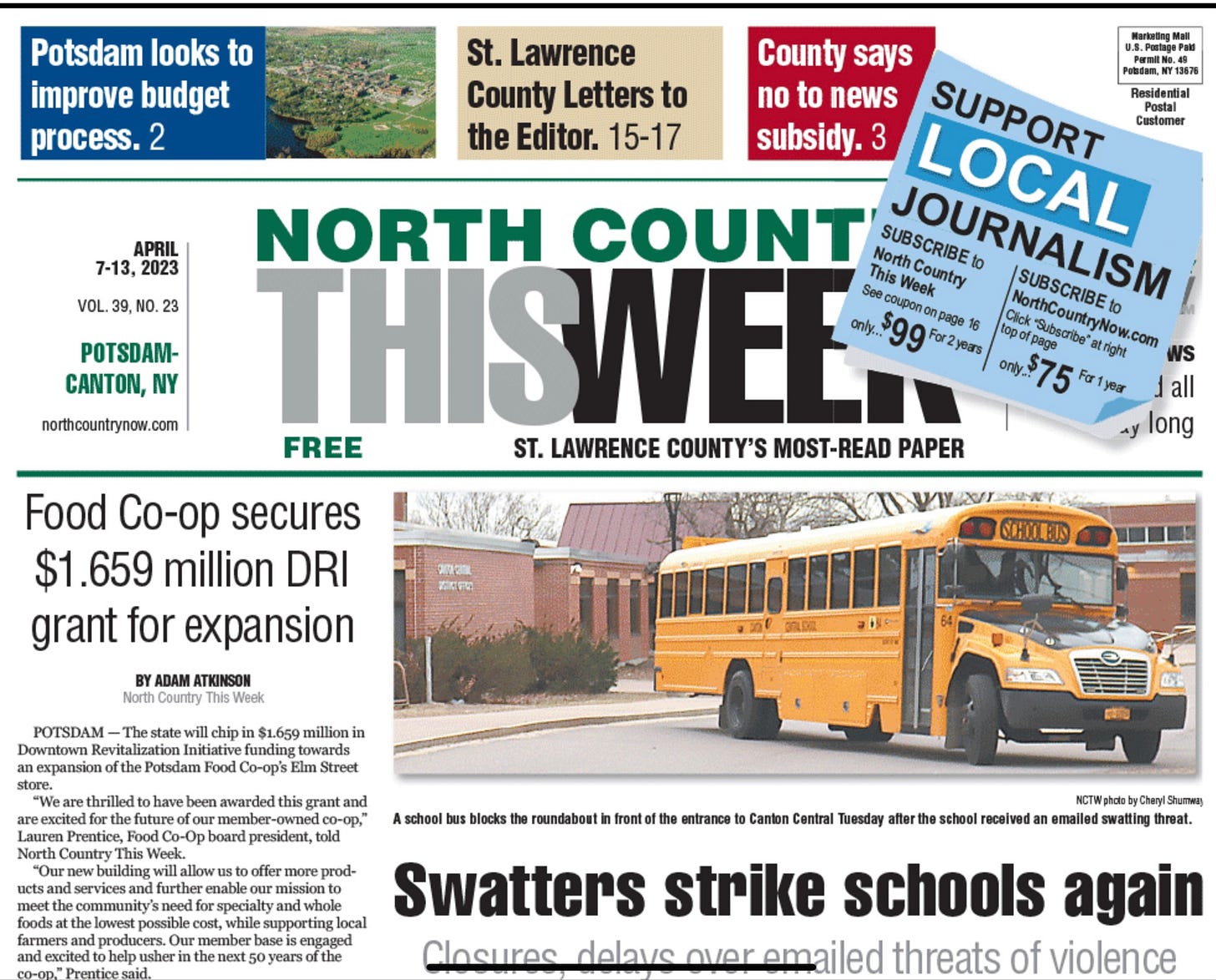Weekly newspapers continuing to make a difference in local communities
Brooks to speak at Skidmore; ProPublica story is a must read
By Ken Tingley
There was always a certain pecking order for newspapers.
Working in upstate New York, readers could buy the New York Times, New York Daily News and New York Post on the newsstand if they wanted, but I never considered them competition because there was no local news.
Then there were the larger regional newspapers like the Albany Times Union and the Daily Gazette in Schenectady. Both circulated throughout the region and often competed with us on Glens Falls and regional stories, but they could not match our breadth of local coverage in Glens Falls and around the region.
Daily newspapers like The Post-Star and The Saratogian in Saratoga Springs ruled their home markets and its suburbs because they covered the meetings, the cops and courts and published the obituaries so important to local readers.
There were various weekly newspapers that provided micro-community coverage that readers in small towns and villages wanted.
At one point 15 years ago, The Post-Star had approximately 45 people working in the newsroom and probably 20 to 25 reporters.
When I retired three years ago, there were 10 people left in the newsroom and six reporters. There are now just three reporters.
When I was doing an interview for Mountain Lake PBS earlier this year, I was told the Press-Republican in Plattsburgh had just one reporter.
While speaking to a group in Potsdam last month, I learned the Watertown Daily Times bureau there had just one reporter.
It was at that event that Mark Basham, the marketing manager for North Country This Week, approached me and talked to me about the newspaper and website at his newspaper. He has been there 30 years. He left me a packet of information and copies of the newspaper to review.
But first he told me something that grabbed my attention.
North Country This Week had five reporters and four salespeople.
They were providing home delivery and circulation was about 7,839.
In a world where the dailies once ruled, it appeared this weekly was now the leader in its market.
The Potsdam/Canton market has always been unique with four colleges - Clarkson, St. Lawrence, SUNY Potsdam and SUNY Canton - providing a white collar readership to go with the mostly blue collar communities surrounding it.
Looking at North Country This Week, it does not look like most weekly newspapers. It had local obituaries, legal ads and a vibrant editorial page.
“We are addressing the same things you are: transparency, democracy and what happens if North Country This Week were to disappear,” Basham said. “Who will provide a trusted, reliable news source?”
The funeral homes provide all the obituaries and it was a big breakthrough when the newspaper landed lucrative legal notices from local government.
Basham says there is an understanding within the local community of the importance of the newspaper’s mission and many try to support that any way they can.
The advertising team has been creative in trying to find niche products that advertisers can get behind.
The digital product also is popular with 5 million page views a month.
Basham, who is nearing retirement, believes the model is sustainable.
This past week, I found myself talking to a roomful of journalists at the New York Press Association Spring Conference.
The New York Press Association is predominantly made up of small weekly and daily newspapers from all over the state. Ten years ago it was seen as the poor stepchild to the New York State Associated Press Association and its daily newspaper members. But the room that day of eager young people to learn insights into the job they were doing was familiar.
I wondered if this was the new front line for community journalism.
After my presentation, I found myself talking to a young woman who was editor of her newspaper on Long Island. Actually, she was everything at the newspaper.
She was frustrated. She had been religiously covering a local controversy about alternative energy. At the meetings, she heard angry citizens complaining that there was no media coverage.
You could tell, it made her mad. People did not seem to know her little newspaper even existed. She wanted to know how to change that.
Where once newspapers like The Post-Star in Glens Falls provided one-stop shopping for their communities, it is obvious now that citizens are going to have to turn to other sources to get a full picture of the news happening around them.
The weekly newspapers that once picked up the scraps of local news the dailies had missed are gong to be playing a larger and larger roles.
So are the new digital startups like Foothills Business Daily which has been covering Saratoga Springs closely and gradually picking up Glens Falls news as well.
The media worlds is changing and we are going to have to change with it.
Brooks at Skidmore
David Brooks, the conservative New York Times columnist with a soul, will be speaking at Skidmore College on Saturday, April 15 at 3:30 p.m.
A reader sent me a description of the day-long program titled “Speech and Expression on College Campuses,” and wondered if Rep. Elise Stefanik might be able to learn something from attending.
“A lot of times, we fail to dive into the other person’s perspective,” Skidmore Senior Kiryat Hance said. “I’ve learned in class that’s something I need to do. Professor Prasad helped me question my assumptions. It was eye-opening, and so my goal in participating in the symposium is to have other people experience that same thing — for them to step out of their comfort zone.”
Here’s the line that Rep. Stefanik should consider carefully:
“Listening and understanding to others is a skill, but it is a skill that can be taught,”Hance said.
There will be a faculty panel discussion at 9:15 and a student panel discussion at 10:45 before Brooks speaks at 3:30.
UAlbany speaker heckled
On the other side of the issue, the University at Albany students who refused to let a conservative speaker take the stage last week might want to attend the seminar to learn something.
The Times Union reported that Ian Haworth, a writer and podcast host had been invited to the college by a conservative student group. Haworth had previously tweeted his opposition to transgender surgery on children.
Students chanted epithets to drown out the speaker trying to introduce Haworth. After an hour, the the event was moved to another smaller meeting where Haworth gave a 20-minute speech to the conservative group that had invited him.
Read this story
Most of you have heard of ProPublica before.
It is a nonprofit online news organization with a reputation for doing great in-depth journalism. It has won multiple Pulitzer Prizes and was a finalist for two Pulitzers in 2022.
Last week, ProPublica released in-depth reporting about how Supreme Court Justice Clarence Thomas has repeatedly received free vacations to exotic locations from a billionaire with ties to conservative causes without every reporting the gifts.
That is against the law.
If you are going to read any story this week, read this one.





Can we talk about the protest at SUNY Albany for a second? Old media do not understand what is happening with these sorts of protests. The far right through organizations like TP USA (https://en.wikipedia.org/wiki/Turning_Point_USA) has created astroturf “clubs” on college campuses that lobby for lectures by extremists whose objective is not free expression but the end of liberal free exchange of ideas. Without the interjection of $$ by libertarian extremist billionaires there wouldn’t be “clubs” lobbying for literal fascists and white nationalists, people like Richard Spenser, to come speak at universities. Ian Haworth is not a principled conservative in the vein of David Brooks and his free speech is not being curtailed in any meaningful sense. He is a podcaster, writer, regular contributor to Fox FakeNews. He is exactly the sort of speaker Harlan Crow, collector of Nazi memorabilia, might fund.
Hi Ken, I live in Central NY-- outside Syracuse. Our local paper (we used to have two papers, one morning paper and one evening paper and a Sunday edition) is now one paper published about three times a week and Sundays as well as produces a daily online newsletter. I subscribe to it to support local news but it does seem inadequate. I truly feel that communities need more than just one newspaper as there should be more than one editorial point of view presented in the community. I feel it is even more imperative that Syracuse and the county we are located due to the fact that a major school of import and reputation at Syracuse University is the Newhouse School of Public Communications and another major school of import is the Maxwell School of Citizenship and Public Affairs. It is a sad situation that our public commentary in this county is so limited with such resources available.